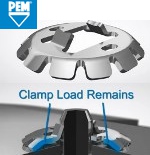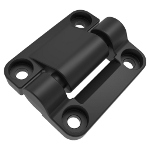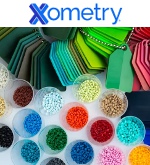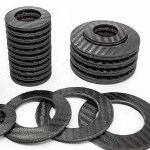 |
| January 16, 2024 | Volume 20 Issue 02 |
Mechanical News & Products
Designfax weekly eMagazine
Archives
Partners
Manufacturing Center
Product Spotlight
Modern Applications News
Metalworking Ideas For
Today's Job Shops
Tooling and Production
Strategies for large
metalworking plants
New 'breathable' rupture disk tech provides overpressure and vacuum relief
 To increase equipment safety and reliability, a new rupture disk technology activates at a set burst pressure, but it can also "breathe" to relieve minor pressure fluctuations. The patent-pending, dual-function device from BS&B Safety Systems is ideal for use on low-pressure vessels that are susceptible to ambient temperature changes.
To increase equipment safety and reliability, a new rupture disk technology activates at a set burst pressure, but it can also "breathe" to relieve minor pressure fluctuations. The patent-pending, dual-function device from BS&B Safety Systems is ideal for use on low-pressure vessels that are susceptible to ambient temperature changes.
Read the full article.
Engineer's Toolbox: 9 considerations for specifying a slewing ring bearing
 In applications that require a bearing to support a structure while it rotates (e.g., cranes, radar, tank turrets), premature bearing failure can put people and equipment at risk. While slewing ring bearings have proven themselves countless times in such applications, designers must consider many factors when specifying them. According to engineers at Kaydon, the bearing's support structure, mounting (including bolt strength, tensioning, and hole patterns), installation, and even storage are all factors in a bearing's success or failure.
In applications that require a bearing to support a structure while it rotates (e.g., cranes, radar, tank turrets), premature bearing failure can put people and equipment at risk. While slewing ring bearings have proven themselves countless times in such applications, designers must consider many factors when specifying them. According to engineers at Kaydon, the bearing's support structure, mounting (including bolt strength, tensioning, and hole patterns), installation, and even storage are all factors in a bearing's success or failure.
Read the full article.
ClampDisk micro fastener is new alternative for automotive and consumer electronics
 Designed as a unique alternative in assemblies for the automotive and consumer electronics markets, the ClampDisk Press-on Fastener is a new offering from PennEngineering that delivers a fast, simple way to achieve sheet-to-sheet clamped fastening while replacing the use of standard screws, nuts, and adhesives. The most common challenges that can be eliminated or reduced by using ClampDisk include over installation, cross threading, stripped screw heads, broken screws, and damaged product. This fastener can be removed easily with a sharp-edged tool.
Designed as a unique alternative in assemblies for the automotive and consumer electronics markets, the ClampDisk Press-on Fastener is a new offering from PennEngineering that delivers a fast, simple way to achieve sheet-to-sheet clamped fastening while replacing the use of standard screws, nuts, and adhesives. The most common challenges that can be eliminated or reduced by using ClampDisk include over installation, cross threading, stripped screw heads, broken screws, and damaged product. This fastener can be removed easily with a sharp-edged tool.
Learn more and see how ClampDisk works.
New nylon constant torque hinge
 Southco has expanded its line of E6 Constant Torque Hinges with a compact, nylon version designed for small applications. The newest addition to the company's E6 50 Constant Torque Position Control Hinge series measures 45 mm with a torque range of 4 to 16 in./lb and is 65% lighter compared to the standard E6 50 Hinge. It provides constant resistance throughout the entire range of motion, enabling users to easily position doors, display screens, and other mounted components and hold them securely at any desired angle.
Southco has expanded its line of E6 Constant Torque Hinges with a compact, nylon version designed for small applications. The newest addition to the company's E6 50 Constant Torque Position Control Hinge series measures 45 mm with a torque range of 4 to 16 in./lb and is 65% lighter compared to the standard E6 50 Hinge. It provides constant resistance throughout the entire range of motion, enabling users to easily position doors, display screens, and other mounted components and hold them securely at any desired angle.
Learn more.
What injection molding material do I use?
 How do you decide what type of plastic to use for your next injection molding project? Xometry can help you narrow your choices. Discover the different strengths and applications for materials that could be ideal for your application by learning about the most common plastic injection molding materials in detail.
How do you decide what type of plastic to use for your next injection molding project? Xometry can help you narrow your choices. Discover the different strengths and applications for materials that could be ideal for your application by learning about the most common plastic injection molding materials in detail.
Read this detailed Xometry article.
What are carbon composite bellows springs?
 The Carbon Composite Bellows Spring (CCBS) from MW Components is a system of carbon fiber elements that combine to work as a high-performance, lightweight, and design-flexible compression spring meant to replace coil springs or metallic Belleville disc springs. A functional spring is made from several individual elements paired and joined to make a stack. The stack spring rate is determined by the number of elements, the base rate of each element, and their series or parallel orientation in the stack. Applications include motorsports, aerospace, and high-performance activities.
The Carbon Composite Bellows Spring (CCBS) from MW Components is a system of carbon fiber elements that combine to work as a high-performance, lightweight, and design-flexible compression spring meant to replace coil springs or metallic Belleville disc springs. A functional spring is made from several individual elements paired and joined to make a stack. The stack spring rate is determined by the number of elements, the base rate of each element, and their series or parallel orientation in the stack. Applications include motorsports, aerospace, and high-performance activities.
Learn more.
Conductive Brush Ring overcomes current leakage in EV powertrains
 SKF's new Conductive Brush Ring paves the way to greater reliability and longer life in high-performance electric vehicle powertrain systems. Using pure carbon fiber bristles, it provides a reliable electrical connection between an EV eAxle rotor shaft and its housing. When used in combination with SKF Hybrid ceramic ball bearings, it helps to alleviate parasitic current effects that can lead to premature failure in bearings and other components. Available in different configurations for wet (oil-lubricated) motor designs -- and soon for dry (sealed) applications.
SKF's new Conductive Brush Ring paves the way to greater reliability and longer life in high-performance electric vehicle powertrain systems. Using pure carbon fiber bristles, it provides a reliable electrical connection between an EV eAxle rotor shaft and its housing. When used in combination with SKF Hybrid ceramic ball bearings, it helps to alleviate parasitic current effects that can lead to premature failure in bearings and other components. Available in different configurations for wet (oil-lubricated) motor designs -- and soon for dry (sealed) applications.
Learn more.
hyperMILL 2024 CAD/CAM software suite
 OPEN MIND Technologies has introduced its latest hyperMILL 2024 CAD/CAM software suite, which includes a range of powerful enhancements to its core toolpath capabilities, as well as new functionality for increased NC programming efficiency in applications ranging from 2.5D machining to 5-axis milling. New and enhanced capabilities include: Optimized Deep Hole Drilling, a new algorithm for 3- and 5-axis Rest Machining, an enhanced path layout for the 3D Plane Machining cycle, better error detection, and much more.
OPEN MIND Technologies has introduced its latest hyperMILL 2024 CAD/CAM software suite, which includes a range of powerful enhancements to its core toolpath capabilities, as well as new functionality for increased NC programming efficiency in applications ranging from 2.5D machining to 5-axis milling. New and enhanced capabilities include: Optimized Deep Hole Drilling, a new algorithm for 3- and 5-axis Rest Machining, an enhanced path layout for the 3D Plane Machining cycle, better error detection, and much more.
Learn more.
One-part epoxy changes from red to clear under UV
 Master Bond UV15RCL is a low-viscosity, cationic-type UV-curing system with a special color-changing feature. The red material changes to clear once exposed to UV light, indicating that there is UV light access across the adhesive material. Although this change in color from red to clear does not indicate a full cure, it does confirm that the UV light has reached the polymer. This epoxy is an excellent electrical insulator. UV15RCL adheres well to metals, glass, ceramics, and many plastics, including acrylics and polycarbonates.
Master Bond UV15RCL is a low-viscosity, cationic-type UV-curing system with a special color-changing feature. The red material changes to clear once exposed to UV light, indicating that there is UV light access across the adhesive material. Although this change in color from red to clear does not indicate a full cure, it does confirm that the UV light has reached the polymer. This epoxy is an excellent electrical insulator. UV15RCL adheres well to metals, glass, ceramics, and many plastics, including acrylics and polycarbonates.
Learn more.
SPIROL Press-N-Lok™ Pin for plastic housings
 The Press-N-Lok™ Pin was designed to permanently retain two plastic components to each other. As the pin is inserted, the plastic backfills into the area around the two opposing barbs, resulting in maximum retention. Assembly time is quicker, and it requires lower assembly equipment costs compared to screws and adhesives -- just Press-N-Lok™!
The Press-N-Lok™ Pin was designed to permanently retain two plastic components to each other. As the pin is inserted, the plastic backfills into the area around the two opposing barbs, resulting in maximum retention. Assembly time is quicker, and it requires lower assembly equipment costs compared to screws and adhesives -- just Press-N-Lok™!
Learn more about the new Press-N-Lok™ Pin.
Why hybrid bearings are becoming the new industry standard
 A combination of steel outer and inner rings with ceramic balls or rollers is giving hybrid bearings unique properties, making them suitable for use in a wide range of modern applications. SKF hybrid bearings make use of silicon nitride (twice as hard as bearing steel) rolling elements and are available as ball bearings, cylindrical roller bearings, and in custom designs. From electric erosion prevention to friction reduction and extended maintenance intervals, learn all about next-gen hybrid bearings.
A combination of steel outer and inner rings with ceramic balls or rollers is giving hybrid bearings unique properties, making them suitable for use in a wide range of modern applications. SKF hybrid bearings make use of silicon nitride (twice as hard as bearing steel) rolling elements and are available as ball bearings, cylindrical roller bearings, and in custom designs. From electric erosion prevention to friction reduction and extended maintenance intervals, learn all about next-gen hybrid bearings.
Read the SKF technical article.
3M and Ansys train engineers on simulating adhesives
 Ansys and 3M have created an advanced simulation training program enabling engineers to enhance the design and sustainability of their products when using tapes and adhesives as part of the design. Simulation enables engineers to validate engineering decisions when analyzing advanced polymeric materials -- especially when bonding components made of different materials. Understand the behavior of adhesives under real-world conditions for accurate modeling and design.
Ansys and 3M have created an advanced simulation training program enabling engineers to enhance the design and sustainability of their products when using tapes and adhesives as part of the design. Simulation enables engineers to validate engineering decisions when analyzing advanced polymeric materials -- especially when bonding components made of different materials. Understand the behavior of adhesives under real-world conditions for accurate modeling and design.
Read this informative Ansys blog.
New FATH T-slotted rail components in black from AutomationDirect
 Automation-Direct has added a wide assortment of black-colored FATH T-slotted hardware components to match their SureFrame black anodized T-slotted rails, including: cube connectors (2D and 3D) and angle connectors, joining plates of many types, brackets, and pivot joints. Also included are foot consoles, linear bearings in silver and black, cam lever brakes, and L-handle brakes. FATH T-slotted hardware components are easy to install, allow for numerous T-slotted structure configurations, and have a 1-year warranty against defects.
Automation-Direct has added a wide assortment of black-colored FATH T-slotted hardware components to match their SureFrame black anodized T-slotted rails, including: cube connectors (2D and 3D) and angle connectors, joining plates of many types, brackets, and pivot joints. Also included are foot consoles, linear bearings in silver and black, cam lever brakes, and L-handle brakes. FATH T-slotted hardware components are easy to install, allow for numerous T-slotted structure configurations, and have a 1-year warranty against defects.
Learn more.
Weird stuff: Moon dust simulant for 3D printing
 Crafted from a lunar regolith simulant, Basalt Moon Dust Filamet™ (not a typo) available from The Virtual Foundry closely mirrors the makeup of lunar regolith found in mare regions of the Moon. It enables users with standard fused filament fabrication (FFF) 3D printers to print with unparalleled realism. Try out your ideas before you go for that big space contract, or help your kid get an A on that special science project.
Crafted from a lunar regolith simulant, Basalt Moon Dust Filamet™ (not a typo) available from The Virtual Foundry closely mirrors the makeup of lunar regolith found in mare regions of the Moon. It enables users with standard fused filament fabrication (FFF) 3D printers to print with unparalleled realism. Try out your ideas before you go for that big space contract, or help your kid get an A on that special science project.
Learn more.
Break the mold with custom injection molding by Rogan
 With 90 years of industry experience, Rogan Corporation possesses the expertise to deliver custom injection molding solutions that set businesses apart. As a low-cost, high-volume solution, injection molding is the most widely used plastics manufacturing process. Rogan processes include single-shot, two-shot, overmolding, and assembly. Elevate your parts with secondary operations: drilling and tapping, hot stamping, special finishes, punch press, gluing, painting, and more.
With 90 years of industry experience, Rogan Corporation possesses the expertise to deliver custom injection molding solutions that set businesses apart. As a low-cost, high-volume solution, injection molding is the most widely used plastics manufacturing process. Rogan processes include single-shot, two-shot, overmolding, and assembly. Elevate your parts with secondary operations: drilling and tapping, hot stamping, special finishes, punch press, gluing, painting, and more.
Learn more.
Military camouflage nets get key tactical upgrades
One major drawback of multispectral camouflage systems is that they neutralize not only enemy radar waves, but also useful radio and GPS signals. Now, Saab's business unit called Barracuda is rewriting the rule book with a camouflage system that manages hostile radar waves while allowing users full access to radio communication and GPS. Saab is based in Stockholm, Sweden.

Saab's Barracuda ULCAS camouflage screening with updated Frequency Selective Surface system shown from the inside. [Credit: Saab]
Ground, air, and satellite-based radar systems represent a major threat to deployed armed forces. By identifying radar-reflective objects, such as tanks, trucks, and aircraft, they deprive troops of both cover and the element of surprise.
Advanced camouflage solutions like Saab's Ultra-Lightweight Camouflage Screen (ULCAS) static nets can neutralize this threat thanks to materials that attenuate or weaken radar pulses. However, up until now, there has been one distinct drawback: The radar attenuating materials in multispectral nets not only neutralize radar waves but also the radio waves used for voice communication and GPS.
"If you are under a traditional multispectral net and you want to communicate using a radio, you generally need to place your antenna outside the net in order to get past the broad spectrum protection and to get a signal," says Dr. Johan Jersblad, a senior development engineer within Saab's business unit Barracuda. "In doing so, you are at risk of exposing yourself to the enemy, which is not ideal, particularly if you're doing forward reconnaissance. In the case of using GPS, you may need to place the entire GPS unit outside the net, and so you are even more exposed."

Can you spot Saab's Barracuda Ultra-Lightweight Camouflage Screen when it is deployed on the ground and viewed from a drone? [Credit: Saab]
Now, a game-changing innovation from Saab´s business unit Barracuda is about to radically alter the situation. Known as the Frequency Selective Surface system (FSS), the solution allows users of specially produced ULCAS nets to make full use of radio and GPS systems while remaining fully concealed.
VIDEO: Saab Barracuda's Ultra-Lightweight Camouflage Screen with the Frequency Selective Surface (ULCAS-FSS) feature represents the next stage in the evolution of advanced signature management technology, delivering an unprecedented degree of freedom when it comes to tactical communications. [Credit: Saab]
"Modern combat situations can evolve rapidly, and it's essential that deployed troops stay in touch," says Jersblad. "Meanwhile, GPS is vital for providing coordinates when you are coordinating air strikes from the ground. With the FSS system for our Barracuda ULCAS system, you can have full access to both these resources without reducing your level of signature management."
Lattice pattern is the key to the system
Jersblad explains the challenge with conventional multispectral nets is that enemy radar systems, radio communication, and GPS all rely on electromagnetic waves. The materials used to attenuate radar waves in conventional multispectral nets not only block common radar frequencies but a wide spectrum of radio waves.
---------------------------
To be released this year, Saab's ULCAS FSS range takes camouflage to the next level. A built-in low-pass filter allows electromagnetic waves for communication and GPS to pass through, while neutralizing the most common radar wavelengths.
The Ultra-Lightweight Camouflage Screen (ULCAS) is the flagship of Saab's Barracuda camouflage range. It is designed to camouflage deployed assets ranging from groups of personnel to static vehicles and command posts. Patterns, colors, and a 3D structure are used to mimic the background of the surrounding terrain, while special pigments help the system to avoid detection by near infrared and short-wave infrared sensors. It also protects against radar reconnaissance and homing missiles in the 1- to 100-GHz range.
---------------------------
"After an inquiry from a potential customer, we began exploring the potential for nets that focused on specifically absorbing the higher frequency electromagnetic waves used by radar systems rather than a broader spectrum," Jersblad says. "The result of this work is a camouflage system where the radar attenuating material is arranged in a lattice pattern. The size and shape of the pattern absorbs high-frequency radar waves but allows radio waves to pass easily through."
Internal network of experts
The ULCAS FSS net produced through this research closely resembles Saab's conventional ULCAS nets. "Looking at it, you can't spot the difference between an ULCAS net with the FSS and a regular one," says Jersblad. "They look and weigh the same and have the same visual and thermal properties. But there is a big difference in terms of being able to communicate without risking exposure."
The new nets represent a major step up from previous attempts to address the radio black-out problem. These include installing radio windows in the netting that were both inconvenient to use and negatively affected signature management.

Saab's updated ULCAS net as seen from ground level. [Credit: Saab]
Saab was at an advantage in developing the system thanks to its broad range of internal competences and wide-ranging knowledge of defense applications. For example, input was received by Saab engineers working with radomes -- protective covers for jet fighter radar systems that allow for the selective absorption of certain radar signals. "Experts from the radome team were able to help doing calculations and performing simulations to create the best pattern solution," says Jersblad.
Customers can have radar protection and communication
The FSS system is currently undergoing final testing with a goal of being released to the market by the end of 2023. Exhaustive field tests have already established its effectiveness at letting useful electromagnetic spectrums in while keeping out undesirable ones.
"The customers who have seen it already have been very impressed," says Jersblad. "One customer said they had left such a feature out of the specifications for their camouflage nets because they didn't think it was possible. Another customer said they had previously sacrificed radar protection in their camouflage so they could maintain their ability to communicate freely. With ULCAS FSS, they no longer have to choose one or the other."
While the initial application of the FSS system is to keep out radar signals while allowing radio waves to pass through, other outcomes can be achieved by changing the pattern design. "For example, by changing the pattern, we could keep communication radio waves out and let radar waves pass through," says Jersblad. "This might be useful if you have a radar operating under the net."
Learn more about Saab's camouflage systems at saab.com/products/land/camouflage-systems.
Source: Saab
Published September 2023
Rate this article
View our terms of use and privacy policy

